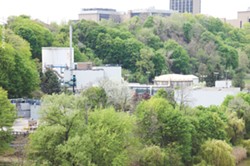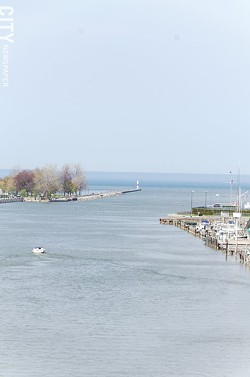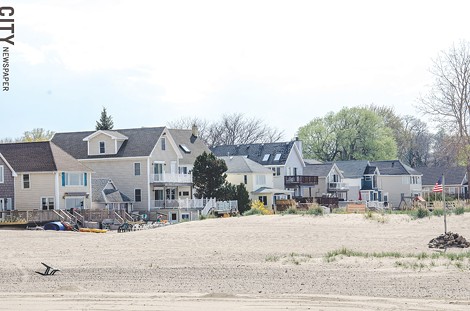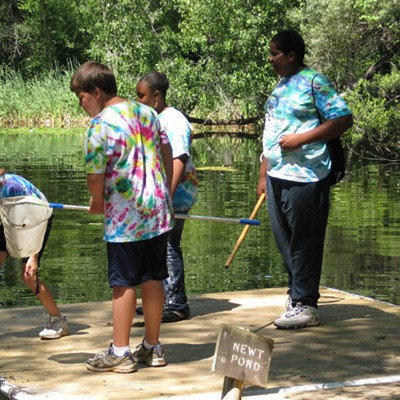
[
{
"name": "500x250 Ad",
"insertPoint": "5",
"component": "15667920",
"parentWrapperClass": "",
"requiredCountToDisplay": "1"
}
]
Much of California is coping with a severe, multi-year drought. The state's water supplies and reservoirs are depleted, urban residents are now required to limit their water use, and many farms in the state are losing their crops.
By comparison, the Rochester region is hydrologically gifted. Lake Ontario provides people, farms, and businesses with massive quantities of water for drinking, irrigation, food production, manufacturing, and more. The lake supports a commercial shipping industry and is a valuable asset for recreational activities such as boating, fishing, and swimming.
The Genesee River, which cuts northbound through the area before emptying into the lake, bolsters agriculture and industry. And it, too, has vast recreational potential.
The region's water resources provide many benefits, but that wet bounty shouldn't be taken for granted: the lake and river face a host of evolving threats and problems.
In the Genesee River, toxic substances that were discharged by industries decades ago persist in the sediment. And in Lake Ontario — along with the other Great Lakes — plastic microbeads pose a potential threat to aquatic life.
The good news is that officials are working to address those problems; a handful of government policies and projects could have a positive impact on the Genesee River, Lake Ontario, and the Great Lakes system as a whole, according to environmentalists and conservationists.
For example: a controversial plan for managing Lake Ontario's water levels, which is waiting on approval from the US and Canadian governments, could lead to healthier coastal wetlands.
And within the next two months, the Environmental Protection Agency is set to release a new version of its Clean Water Rule. The regulations, which would still need to be finalized, clarify which seasonal streams and wetlands are protected under the Clean Water Act, EPA officials say.
And at Braddock Bay in the Town of Greece, the US Army Corps of Engineers has developed a plan to retain and restore critical wetlands areas. The bay's wetlands have been declining, in size as well as habitat and wildlife diversity, due to erosion and cattail overgrowth.
The Genesee River's connection to industry is as old as Rochester itself. The water powered the region's early mills and later generated electricity for businesses and homes.
The downside of that historic relationship is that many of the industries also used the river as a dump. Kodak is one of the companies that discharged waste into the river.
As Kodak exited bankruptcy last year, it reached an agreement with the federal Environmental Protection Agency and State Department of Environmental Conservation to provide funding for cleanup work. The company set aside $49 million for the project. The state and Kodak officials agreed to share the expense if costs run higher.
This summer, DEC contractors will start studying a five-mile section of the Genesee, from Route 104 to the Lake Ontario outlet. Their objective is to determine the extent of contamination in the river, how much of the pollution could reasonably be attributed to Kodak's operations, and what cleanup work is warranted.
"I think it's a step in the right direction," says George Thomas, executive director of the Center for Environmental Initiatives, which has led several efforts to improve the river's health.
DEC contractors will test samples of the Genesee's water as well as its sediment, some of its fish species, and mussels or crayfish. They'll also analyze soil samples along the river's banks, and in floodplains and wetlands.
The contractors will test the samples for toxic substances that Kodak was known to handle in large quantities, such as silver. They'll also test for pollutants that have been found in other parts of the river and the near-shore area of Lake Ontario. Those substances include pesticides, heavy metals, dioxins, and PCB's — which can all have harmful effects on people and wildlife.
The DEC says that any contamination will likely be contained in the river's sediment, and possibly in soils along its banks.
The department expects to receive a draft of the findings in early 2016 and to issue a report outlining recommended cleanup actions later that year. The findings could also show that further assessment is needed of contaminants not related to Kodak's historical operations, the DEC says.
On Earth Day, April 22, the State Assembly approved, for the second time, a statewide ban on the sale of products containing microbeads – tiny plastic particles found in cosmetics, facial scrubs, and other personal care items. The legislation was drafted by Attorney General Eric Schneiderman.
The action is significant: in a chamber that can have a sharp ideological divide, a major environmental and industry regulation passed with only one "no" vote (though a few members were absent).
Schneiderman's bill has languished in the Senate, however. The chamber's leadership didn't bring the bill up for a vote last year, and may not this year, either. Republican Tom O'Mara, chair of the Senate Environmental Conservation Committee, introduced Schneiderman's legislation, but also submitted his own competing bill.
Environmental groups don't support O'Mara's bill, which they say differs from Schneiderman's in two significant ways. The O'Mara legislation sets a later start date for the microbeads ban, and only prohibits synthetic microbeads. The bill leaves a loophole that would allow products to contain so-called biodegradable plastic microbeads, which don't break down in the water, environmentalists say.
Microbeads have emerged as a serious concern in a short period of time — the result of research that paints an ever-clearer picture of the severity of the problem. In 2013, SUNY Fredonia chemistry professor Sam Mason first confirmed the presence of microbeads in some of the Great Lakes. Since then, she and other researchers have found microbeads in all of the Great Lakes, with the greatest concentrations found in Lake Ontario.
They've also found that other contaminants in the water — including pesticides, heavy metals, and other toxins — stick to the surfaces of the beads. Fish, birds, and other aquatic organisms ingest the beads, mistaking them for fish eggs. Mason suspects that the beads serve as a pathway for toxins to enter the bodies of those organisms.
"The next question is, do the chemicals desorb into the organism once they're ingested?" Mason says. "That's where we're going next year."
Until the state has a ban on microbeads, consumers can make a difference by choosing products without the plastic pieces in them. The website www.beatthemicrobead.org has lists of products containing microbeads.
"With every dollar we spend, we're choosing the world we want," Mason says.
Braddock Bay is well-known as a crucial stopover for migrating birds, particularly waterfowl. But each year, the bay loses about an acre of coastal marshland to erosion, which is caused primarily by strong waves coming in off of the lake during storms.
In addition, invasive cattails have taken over parts of the wetlands, reducing the variety of habitat available to fish, water birds, and mammals such as muskrat and mink.
The US Army Corps of Engineers has developed a plan to substantially reduce erosion and restore habitat diversity in the bay wetlands. It presented the plan to the public last week in Greece.
The Corps wants to build an artificial barrier at the mouth of the bay to break waves. The structure would be built out of limestone boulders, and the spaces between the rocks would be filled with sand and plants that match the surrounding environment. It'd also have channels on either end, which will allow water to circulate between the bay and the lake.
The bay has been unprotected from waves since Hurricane Agnes in 1972, which washed out the sand barrier beach at the bay's mouth.
"We ended up picking what we thought would most accurately function and replicate the barrier beach that would historically be present at Braddock Bay," says Josh Unghire, a Corps restoration ecologist and planner on the Braddock Bay project.
The Corps also wants to remove cattails from some parts of the wetlands and to build a network of potholes — basically small, shallow ponds — connected by channels. That work will provide water birds, mammals, and amphibians with breaks in the dense cattail growth, which will diversify the wetland habitat. The Corps also plans to re-establish a segment of shoreline marsh next to an existing area of the same wetland type.
Black terns have historically nested in the bay wetlands, but the birds prefer to build their nests in open areas of marshes. They haven't been seen nesting in the bay since the 1990's, and the Corps hopes creating areas that are attractive to the black tern will bring them back.
Braddock Bay's wetlands and coastal wetlands across Lake Ontario could benefit if the federal government signs off on Plan 2014. The proposal was developed by the US-Canadian International Joint Commission and contains a new set of guidelines to regulate water flows between Lake Ontario and the St. Lawrence River. Those flows influence water levels in the lake.
The plan that's currently in place was developed in the 1950's and holds levels relatively stable. But it's contributed to an environment where cattails thrive — taking over other important types of wetlands.
Plan 2014's supporters say that it would provide for a greater, more natural variation in the lake's water levels over time. The fluctuation would, in turn, lead to greater diversity of wetland types, they say. Opponents say that the plan would cause erosion to shoreline properties, and that owners won't be compensated for the damage.
Since it's an international agreement, the plan needs the approval of President Barack Obama. The Department of State is currently reviewing the proposal and will make a recommendation to the president. Canada's government must also approve Plan 2014.
"This is a great deal for shipping and recreation and shoreline property owners," says Jim Howe, executive director of the Nature Conservancy of Central and Western New York. "It's a balanced plan. It really restores the environment of the lake in a way that respects all the other interests."














